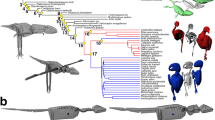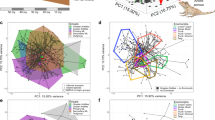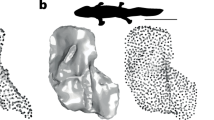Abstract
The origin of birds from theropod dinosaurs involves many changes in musculoskeletal anatomy and epidermal structures, including multiple instances of convergence and homology-related traits that contribute to the refinement of flight capability. Changes in limb sizes and proportions are important for locomotion (for example, the forelimb for bird flight); thus, understanding these patterns is central to investigating the transition from terrestrial to volant theropods. Here we analyse the patterns of morphological disparity and the evolutionary rate of appendicular limbs along avialan stem lineages using phylogenetic comparative approaches. Contrary to the traditional wisdom that an evolutionary innovation like flight would promote and accelerate evolvability, our results show a shift to low disparity and decelerated rate near the origin of avialans that is largely ascribed to the evolutionarily constrained forelimb. These results suggest that natural selection shaped patterns of limb evolution close to the origin of avialans in a way that may reflect the winged forelimb ‘blueprint’ associated with powered flight.
This is a preview of subscription content, access via your institution
Access options
Access Nature and 54 other Nature Portfolio journals
Get Nature+, our best-value online-access subscription
$29.99 / 30 days
cancel any time
Subscribe to this journal
Receive 12 digital issues and online access to articles
$119.00 per year
only $9.92 per issue
Buy this article
- Purchase on Springer Link
- Instant access to full article PDF
Prices may be subject to local taxes which are calculated during checkout





Similar content being viewed by others
Data availability
Supplementary material is available online. The R code, raw data and results derived from the phylogeny scaled using the ‘equal’ method, and the different phylogenetic hypotheses are available on the OSF (https://osf.io/8n3wt/?view_only=753148d6a15f478e8fa027890b6b9bde).
Code availability
The R code used in the comparative analyses is archived and available on the OSF (https://osf.io/8n3wt/?view_only=753148d6a15f478e8fa027890b6b9bde).
References
Brusatte, S. L., O’Connor, J. K. & Jarvis, E. D. The origin and diversification of birds. Curr. Biol. 25, R888–R898 (2015).
Xu, X. et al. An integrative approach to understanding bird origins. Science 346, 1253293 (2014).
Middleton, K. M. & Gatesy, S. M. Theropod forelimb design and evolution. Zool. J. Linn. Soc. 128, 149–187 (2000).
Gatesy, S. M. & Dial, K. P. Locomotor modules and the evolution of avian flight. Evolution 50, 331–340 (1996).
Lee, M. S. Y., Cau, A., Naish, D. & Dyke, G. J. Sustained miniaturization and anatomical innovation in the dinosaurian ancestors of birds. Science 345, 562–566 (2014).
Dececchi, T. A. & Larsson, H. C. E. Body and limb size dissociation at the origin of birds: uncoupling allometric constraints across a macroevolutionary transition. Evolution 67, 2741–2752 (2013).
Benson, R. B. J. & Choiniere, J. N. Rates of dinosaur limb evolution provide evidence for exceptional radiation in Mesozoic birds. Proc. Biol. Sci. 280, 20131780 (2013).
Hedrick, B. P., Manning, P. L., Lynch, E. R., Cordero, S. A. & Dodson, P. The geometry of taking flight: limb morphometrics in Mesozoic theropods. J. Morphol. 276, 152–166 (2015).
Benson, R. B. J. et al. Rates of dinosaur body mass evolution indicate 170 million years of sustained ecological innovation on the avian stem lineage. PLoS Biol. 12, e1001853 (2014).
Hone, D. W. E., Dyke, G. J., Haden, M. & Benton, M. J. Body size evolution in Mesozoic birds. J. Evol. Biol. 21, 618–624 (2008).
Butler, R. J. & Goswami, A. Body size evolution in Mesozoic birds: little evidence for Cope’s rule. J. Evol. Biol. 21, 1673–1682 (2008).
Wang, M., O’Connor, J. K., Xu, X. & Zhou, Z. A new Jurassic scansoriopterygid and the loss of membranous wings in theropod dinosaurs. Nature 569, 256–259 (2019).
Xu, X. et al. Two Early Cretaceous fossils document transitional stages in alvarezsaurian dinosaur evolution. Curr. Biol. 28, 2853–2860 (2018).
Ruiz, J., Torices, A., Serrano, H. & López, V. The hand structure of Carnotaurus sastrei (Theropoda, Abelisauridae): implications for hand diversity and evolution in abelisaurids. Palaeontology 54, 1271–1277 (2011).
Gatesy, S. M. Hind limb scaling in birds and other theropods: implications for terrestrial locomotion. J. Morphol. 209, 83–96 (1991).
Allen, V. R., Kilbourne, B. M. & Hutchinson, J. R. The evolution of pelvic limb muscle moment arms in bird-line archosaurs. Sci. Adv. 7, eabe2778 (2021).
Dececchi, T. A. & Larsson, H. C. E. Assessing arboreal adaptations of bird antecedents: testing the ecological setting of the origin of the avian flight stroke. PLoS ONE 6, e22292 (2011).
Nudds, R. L., Dyke, G. J. & Rayner, J. M. V. Avian brachial index and wing kinematics: putting movement back into bones. J. Zool. 272, 218–226 (2007).
Wang, X. & Clarke, J. A. Phylogeny and forelimb disparity in waterbirds. Evolution 68, 2847–2860 (2014).
Pei, R. et al. Potential for powered flight neared by most close avialan relatives, but few crossed its thresholds. Curr. Biol. 30, 4033–4046 (2020).
Cooney, C. R. et al. Mega-evolutionary dynamics of the adaptive radiation of birds. Nature 542, 344–347 (2017).
Erwin, D. H. Novelty and innovation in the history of life. Curr. Biol. 25, R930–R940 (2015).
Sullivan, C., Xu, X. & O’Connor, J. K. Complexities and novelties in the early evolution of avian flight, as seen in the Mesozoic Yanliao and Jehol Biotas of Northeast China. Palaeoworld 26, 212–229 (2017).
Brusatte, S. L., Lloyd, G. T., Wang, S. C. & Norell, M. A. Gradual assembly of avian body plan culminated in rapid rates of evolution across the dinosaur-bird transition. Curr. Biol. 24, 2386–2392 (2014).
Sullivan, C., Hone, D. W. E., Xu, X. & Zhang, F. The asymmetry of the carpal joint and the evolution of wing folding in maniraptoran theropod dinosaurs. Proc. Biol. Sci. 277, 2027–2033 (2010).
Wang, M. & Zhou, Z. in The Biology of the Avian Respiratory System (ed. Maina N. J.) 1–26 (Springer International Publishing, 2017).
Chiappe, L. M. & Walker, C. A. in Mesozoic Birds: Above the Heads of Dinosaurs (eds Chiappe, L. M. & Witmer, L. M.) 240–267 (Univ. California Press, 2002).
Tobias, J. A. et al. AVONET: morphological, ecological and geographical data for all birds. Ecol. Lett. 25, 581–597 (2022).
Dyke, G. J. & Nudds, R. L. The fossil record and limb disparity of enantiornithines, the dominant flying birds of the Cretaceous. Lethaia 42, 248–254 (2009).
Pigot, A. L. et al. Macroevolutionary convergence connects morphological form to ecological function in birds. Nat. Ecol. Evol. 4, 230–239 (2020).
Wang, M. & Lloyd, G. T. Rates of morphological evolution are heterogeneous in Early Cretaceous birds. Proc. Biol. Sci. 283, 20160214 (2016).
Zhang, C. & Wang, M. Bayesian tip dating reveals heterogeneous morphological clocks in Mesozoic birds. R. Soc. Open Sci. 6, 182062 (2019).
Chiappe, L. M. The first 85 million years of avian evolution. Nature 378, 349–355 (1995).
Gatesy, S. M. & Middleton, K. M. Bipedalism, flight, and the evolution of theropod locomotor diversity. J. Vertebr. Paleontol. 17, 308–329 (1997).
Turner, A. H., Makovicky, P. J. & Norell, M. A. A review of dromaeosaurid systematics and paravian phylogeny. Bull. Am. Mus. Nat. Hist. 371, 1–206 (2012).
Pol, D. & Goloboff, P. A. The impact of unstable taxa in coelurosaurian phylogeny and resampling support measures for parsimony analyses. Bull. Am. Mus. Nat. Hist. 440, 97–115 (2020).
Wang, M., Lloyd, G. T., Zhang, C. & Zhou, Z. The patterns and modes of the evolution of disparity in Mesozoic birds. Proc. Biol. Sci. 288, 20203105 (2021).
Lee, Y.-N. et al. Resolving the long-standing enigmas of a giant ornithomimosaur Deinocheirus mirificus. Nature 515, 257–260 (2014).
Rauhut, O. W. M. & Pol, D. Probable basal allosauroid from the early Middle Jurassic Cañadón Asfalto Formation of Argentina highlights phylogenetic uncertainty in tetanuran theropod dinosaurs. Sci. Rep. 9, 18826 (2019).
O’Connor, J. K. & Sullivan, C. Reinterpretation of the Early Cretaceous maniraptoran (Dinosauria: Theropoda) Zhongornis haoae as a scansoriopterygid-like non-avian, and morphological resemblances between scansoriopterygids and basal oviraptorosaurs. Vertebr. PalAsiat. 52, 3–30 (2014).
Paradis, E., Claude, J. & Strimmer, K. APE: analyses of phylogenetics and evolution in R language. Bioinformatics 20, 289–290 (2004).
Bapst, D. W. paleotree: an R package for paleontological and phylogenetic analyses of evolution. Methods Ecol. Evol. 3, 803–807 (2012).
Stadler, T. Sampling-through-time in birth–death trees. J. Theor. Biol. 267, 396–404 (2010).
Bapst, D. W. A stochastic rate-calibrated method for time-scaling phylogenies of fossil taxa. Methods Ecol. Evol. 4, 724–733 (2013).
Ballell, A., Moon, B. C., Porro, L. B., Benton, M. J. & Rayfield, E. J. Convergence and functional evolution of longirostry in crocodylomorphs. Palaeontology 62, 867–887 (2019).
Herrera-Flores, J. A., Stubbs, T. L. & Benton, M. J. Ecomorphological diversification of squamates in the Cretaceous. R. Soc. Open Sci. 8, 201961 (2021).
Gavryushkina, A. & Zhang, C. in The Molecular Evolutionary Clock: Theory and Practice (ed. Ho, S. Y. W.) 175–193 (Springer, 2020).
Wright, A. M., Bapst, D. W., Barido-Sottani, J. & Warnock, R. C. M. Integrating fossil observations into phylogenetics using the fossilized birth–death model. Annu. Rev. Ecol. Evol. Syst. 53, 251–273 (2022).
Benson, R. B. J., Godoy, P., Bronzati, M., Butler, R. J. & Gearty, W. Reconstructed evolutionary patterns for crocodile-line archosaurs demonstrate impact of failure to log-transform body size data. Commun. Biol. 5, 171 (2022).
Revell, L. J. Size-correction and principal components for interspecific comparative studies. Evolution 63, 3258–3268 (2009).
Revell, L. J. phytools: an R package for phylogenetic comparative biology (and other things). Methods Ecol. Evol. 3, 217–223 (2012).
Grafen, A. The phylogenetic regression. Philos. Trans. R. Soc. Lond. B Biol. Sci. 326, 119–157 (1989).
Campione, N. E. & Evans, D. C. A universal scaling relationship between body mass and proximal limb bone dimensions in quadrupedal terrestrial tetrapods. BMC Biol. 10, 60 (2012).
Felsenstein, J. Phylogenies and the comparative method. Am. Nat. 125, 1–15 (1985).
Wills, M. A., Briggs, D. E. G. & Fortey, R. A. Disparity as an evolutionary index: a comparison of Cambrian and recent arthropods. Paleobiology 20, 93–130 (1994).
Foote, M. Morphological and taxonomic diversity in a clade’s history: the blastoid record and stochastic simulations. Contrib. Mus. Paleontol. Univ. Mich. 28, 101–140 (1991).
Guillerme, T. dispRity: a modular R package for measuring disparity. Methods Ecol. Evol. 9, 1755–1763 (2018).
Oksanen, J. et al. Package ‘vegan’. Community Ecology Package. R package version 2.6-2 https://cran.r-project.org/web/packages/vegan/vegan.pdf (2007).
Nudds, R. L., Dyke, G. J. & Rayner, J. M. V. Forelimb proportions and the evolutionary radiation of Neornithes. Proc. Biol. Sci. 271, S324–S327 (2004).
Samuels, J. X. & Van Valkenburgh, B. Skeletal indicators of locomotor adaptations in living and extinct rodents. J. Morphol. 269, 1387–1411 (2008).
Zeffer, A., Johansson, L. C. & Marmebro, Å. Functional correlation between habitat use and leg morphology in birds (Aves). Biol. J. Linn. Soc. Lond. 79, 461–484 (2003).
Plummer, M., Best, N., Cowles, K. & Vines, K. CODA: convergence diagnosis and output analysis for MCMC. R. News 6, 7–11 (2006).
Felice, R. N. et al. Decelerated dinosaur skull evolution with the origin of birds. PLoS Biol. 18, e3000801 (2020).
Acknowledgements
We thank R. N. Felice for help in calculating the evolutionary rates in R. This research is supported by the National Natural Science Foundation of China (nos. 42225201 and 42288201), the Key Research Program of Frontier Sciences, the Chinese Academy of Sciences (no. ZDBS-LY-DQC002) and the Tencent Foundation (through the XPLORER PRIZE).
Author information
Authors and Affiliations
Contributions
M.W. conceived the project. M.W. and Z.Z. performed the analyses and wrote the manuscript.
Corresponding author
Ethics declarations
Competing interests
The authors declare no competing interests.
Peer review
Peer review information
Nature Ecology & Evolution thanks Stephen Brusatte and Gregory Funston for their contribution to the peer review of this work.
Additional information
Publisher’s note Springer Nature remains neutral with regard to jurisdictional claims in published maps and institutional affiliations.
Extended data
Extended Data Fig. 1 Evolutionary changes of all appendicular elements across Mesozoic theropod phylogeny.
The first and third principal components (PCs) derived from pPCA of all limbs are mapped on the time-calibrated tree. a, PC1 (=70.03% variances). b, PC3 (=6.7% variances).
Extended Data Fig. 2 Phylomorphospace of forelimb morphological disparity of Mesozoic theropods.
The first three principal components (PCs) derived from pPCA of forelimb are used. a, Binary plot of PCs 1 and 2. b, Binary plot of PCs 1 and 3.
Extended Data Fig. 3 Phylomorphospace of hindlimb morphological disparity of Mesozoic theropods.
The first three principal components (PCs) derived from pPCA of hindlimb are used. a, Binary plot of PCs 1 and 2. b, Binary plot of PCs 1 and 3.
Extended Data Fig. 4 Rarefaction of disparity curves of Mesozoic theropods showing that the results are not strongly affected by sampling bias.
Morphological disparity is quantified using three metrices: a, sum of variances; b, median distance from centroid; c, and sum of ranges. The dark and light surfaces indicate the 50% and 95% confidence intervals, respectively.
Extended Data Fig. 5 Evolutionary changes of brachial (BI) and crural (CI) indices across Mesozoic theropod phylogeny.
a, Phylomorphospace of BI and crural CI indices with phylogeny accounted. b, c, Comparison of disparity among three subgroups using standard deviations of BI (b) and CI (c), respectively (The boxes represent the median, the first and the third quartile of the morphological disparity; n = 109 species). Morphological disparity was compared using Welch’s t-test for statistical significance (****two-sided p-value threshold <0.05).
Extended Data Fig. 6 Comparison of evolutionary rate of subgroups of Mesozoic theropods.
Evolutionary rates are significantly different in all pairwise comparisons. The mean rate scalar is the mean of the rate scalars calculated in the post-burn-in posterior distribution under the variable rate evolutionary model (The boxes represent the median, the first and the third quartile of the mean rate scalar; n = 109 species). a, All appendicular elements. b, Forelimb. c, Hindlimb. Evolutionary rate among subgroups were compared using a nonparametric t-test for statistical significance (****: p < 0.00005).
Extended Data Fig. 7
Evolutionary changes of brachial index across time-calibrated Mesozoic theropod tree.
Extended Data Fig. 8 Evolutionary changes of brachial index across Mesozoic theropod phylogeny.
a, Branch specific evolutionary rates and rate shifts (Branch specific evolutionary rates are denoted by the color gradients. Posterior probabilities of rate shifts are indicated by the relative size of the grey triangles). b, Comparison of evolutionary rate of brachial index among subgroups (The boxes represent the median, the first and the third quartile of the mean rate scalar; n = 109 species). Evolutionary rates are significantly different in all pairwise comparisons except between Avialae and non-paravian theropods.
Extended Data Fig. 9
Evolutionary changes of crural index across time-calibrated Mesozoic theropod tree.
Extended Data Fig. 10 Evolutionary changes of crural index across Mesozoic theropod phylogeny.
a, Branch specific evolutionary rates and rate shifts (Branch specific evolutionary rates are denoted by the color gradients. Posterior probabilities of rate shifts are indicated by the relative size of the grey triangles). b, Comparison of evolutionary rate of brachial index among subgroups (The boxes represent the median, the first and the third quartile of the mean rate scalar; n = 109 species). Evolutionary rates are significantly different in all pairwise comparisons.
Supplementary information
Supplementary Information
Supplementary Figs. 1–23 and Tables 1–11.
Supplementary Table 1
List of taxonomical sampling.
Supplementary Code
The R code, raw data and results derived from the phylogeny scaled using the ‘equal’ method, and different phylogenetic hypotheses.
Rights and permissions
Springer Nature or its licensor (e.g. a society or other partner) holds exclusive rights to this article under a publishing agreement with the author(s) or other rightsholder(s); author self-archiving of the accepted manuscript version of this article is solely governed by the terms of such publishing agreement and applicable law.
About this article
Cite this article
Wang, M., Zhou, Z. Low morphological disparity and decelerated rate of limb size evolution close to the origin of birds. Nat Ecol Evol 7, 1257–1266 (2023). https://doi.org/10.1038/s41559-023-02091-z
Received:
Accepted:
Published:
Issue Date:
DOI: https://doi.org/10.1038/s41559-023-02091-z



